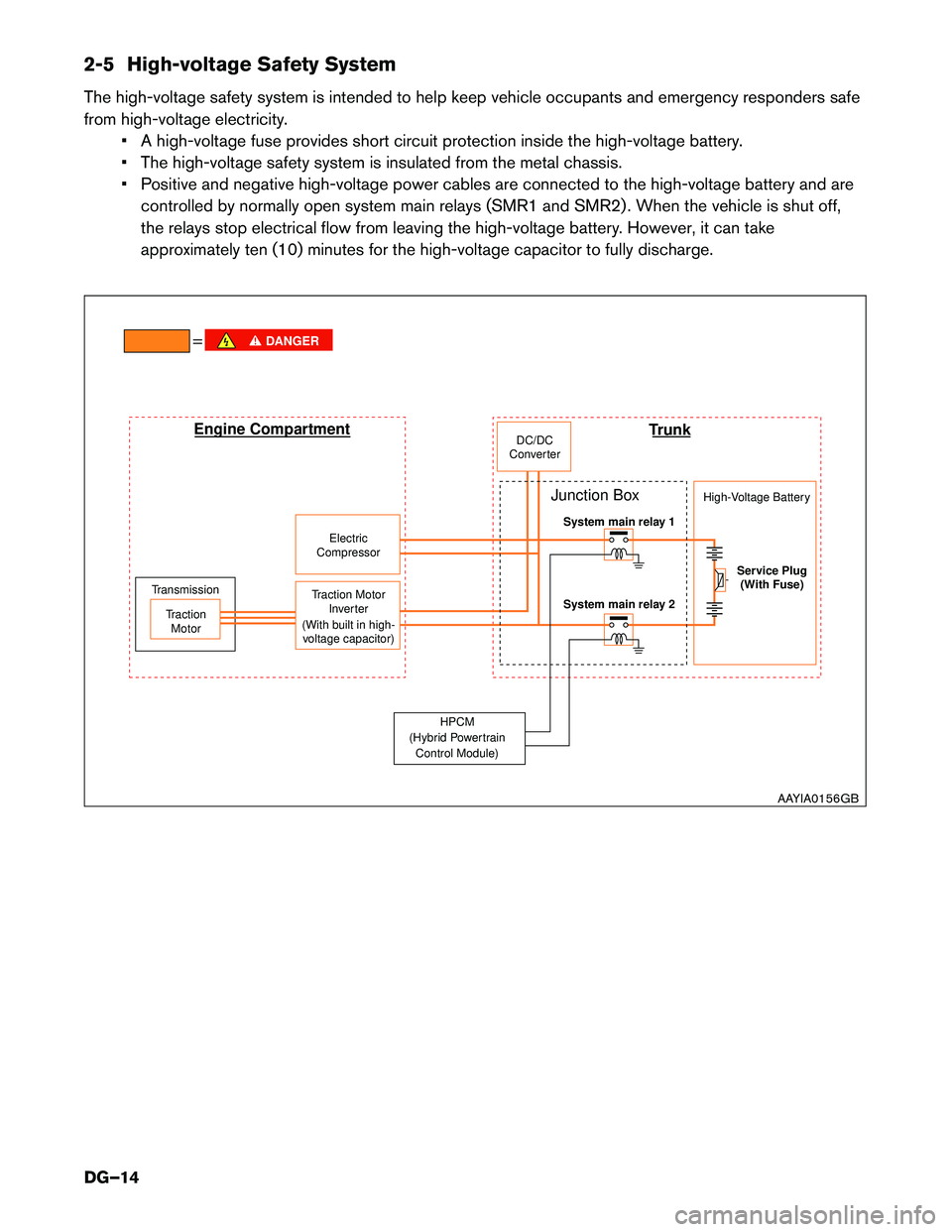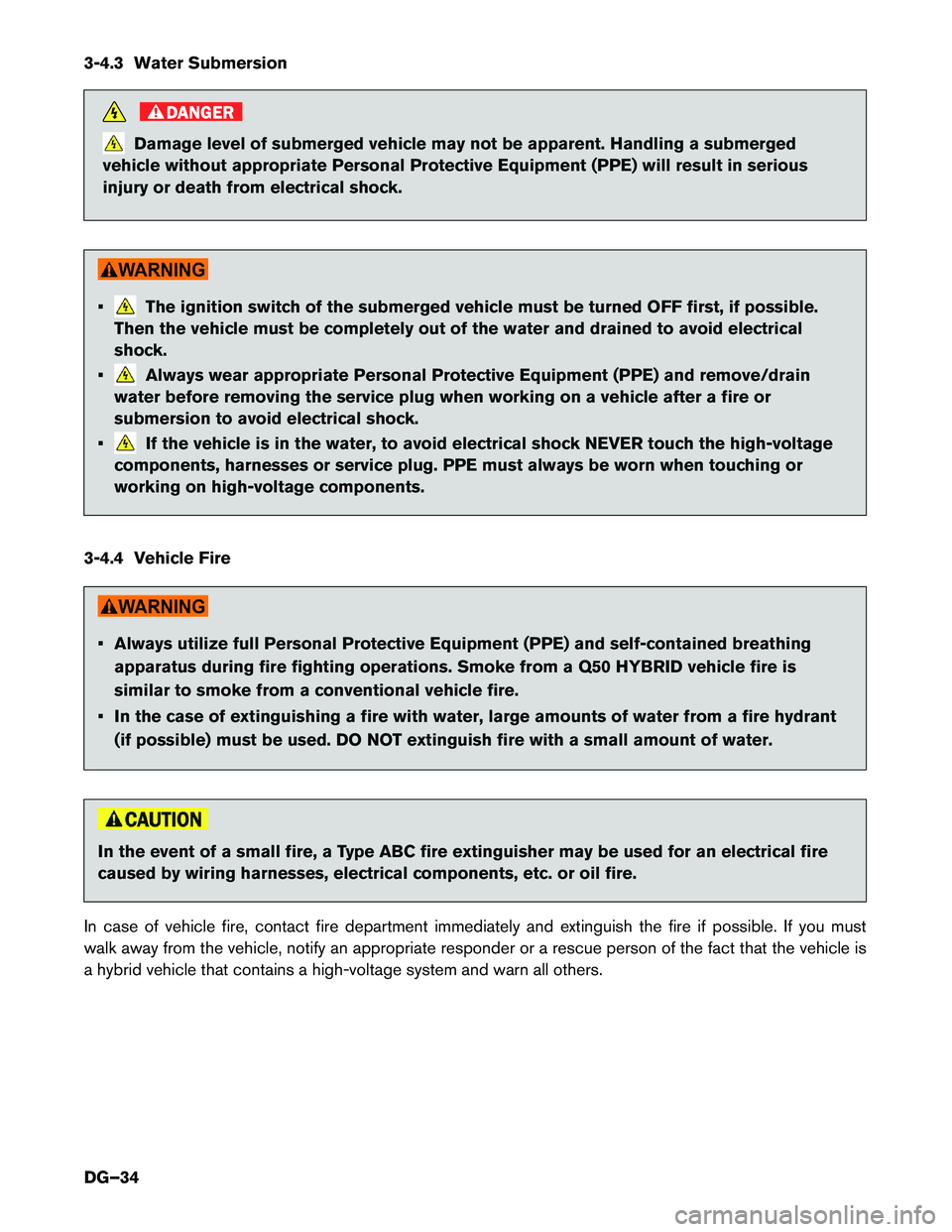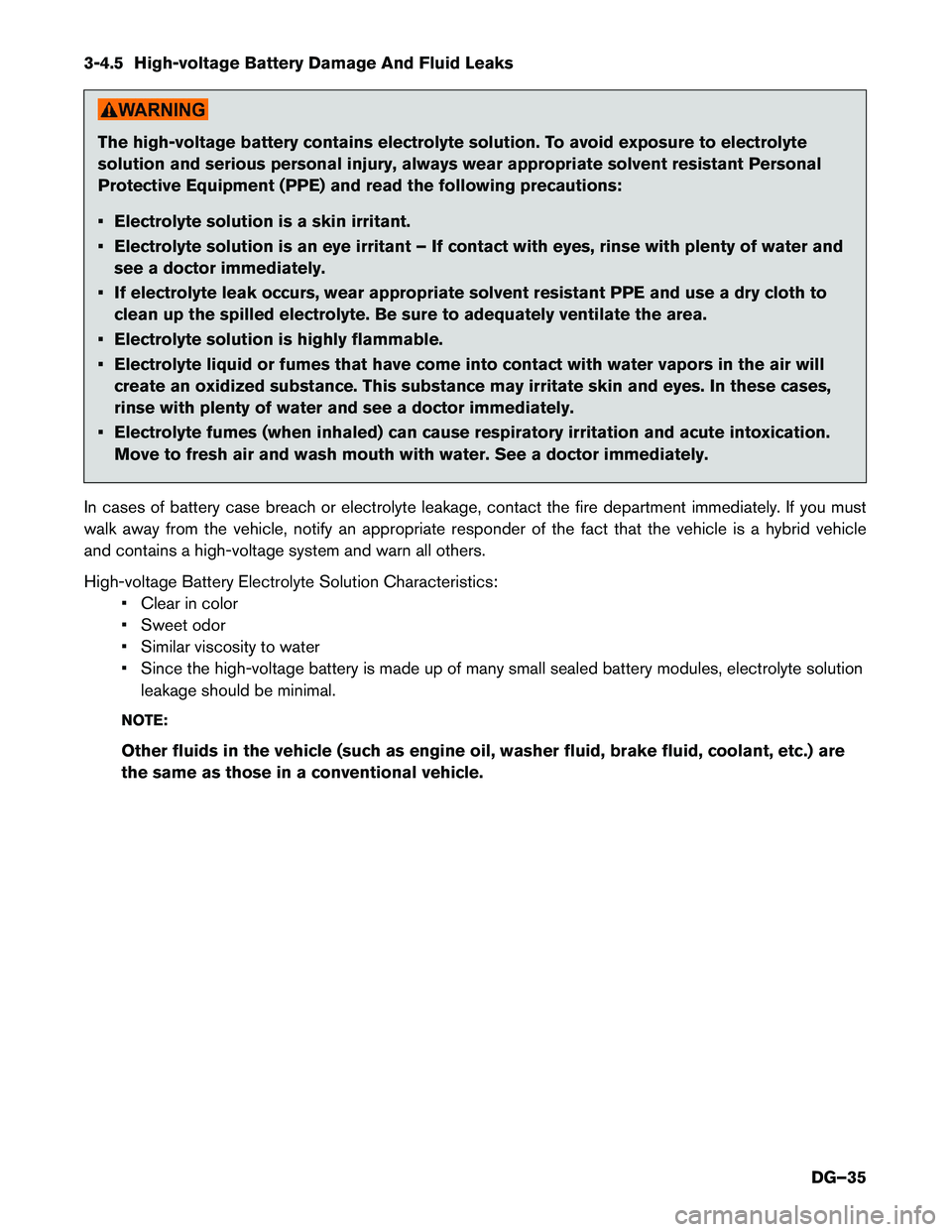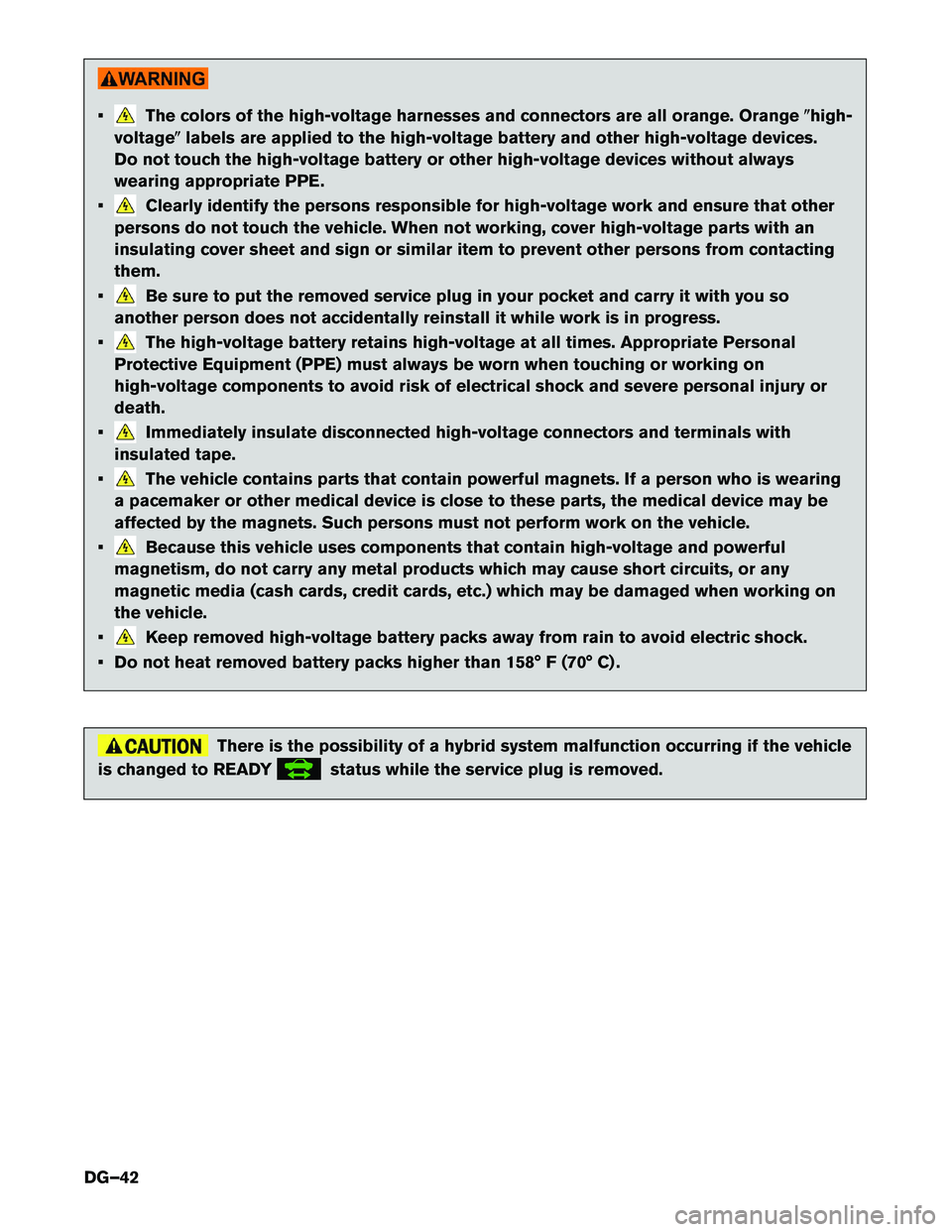ESP INFINITI Q50 HYBRID 2017 Dismantling Guide
[x] Cancel search | Manufacturer: INFINITI, Model Year: 2017, Model line: Q50 HYBRID, Model: INFINITI Q50 HYBRID 2017Pages: 55, PDF Size: 2.25 MB
Page 14 of 55

2-5 High-voltage Safety System
The
high-voltage safety system is intended to help keep vehicle occupants and emergency responders safe
from high-voltage electricity. • A high-voltage fuse provides short circuit protection inside the high-voltage battery.
• The high-voltage safety system is insulated from the metal chassis.
• Positive and negative high-voltage power cables are connected to the high-voltage battery and arecontrolled by normally open system main relays (SMR1 and SMR2) . When the vehicle is shut off,
the relays stop electrical flow from leaving the high-voltage battery. However, it can take
approximately ten (10) minutes for the high-voltage capacitor to fully discharge. Trunk
J
unction Box High-Voltage Battery
System main relay 1
Service Plug (With Fuse)
System main relay 2
Transmission
Traction Motor Traction Motor
Inverter
(With built in high- voltage capacitor) Electric
Compressor DC/DC
Converter
Engine Compartment DANGER
HPCM
(Hybr
id Powertrain
Control Module)
AAYIA0156GB
DG–14
Page 34 of 55

3-4.3 Water Submersion
DANGER
Damage level of submerged vehicle may not be apparent. Handling a submerged
vehicle without appropriate Personal Protective Equipment (PPE) will result in serious
injury or death from electrical shock. • The ignition switch of the submerged vehicle must be turned OFF first, if possible.
Then
the vehicle must be completely out of the water and drained to avoid electrical
shock.
• Always wear appropriate Personal Protective Equipment (PPE) and remove/drain
water
before removing the service plug when working on a vehicle after a fire or
submersion to avoid electrical shock.
• If the vehicle is in the water, to avoid electrical shock NEVER touch the high-voltage
components,
harnesses or service plug. PPE must always be worn when touching or
working on high-voltage components.
3-4.4 Vehicle Fire • Always utilize full Personal Protective Equipment (PPE) and self-contained breathing
apparatus
during fire fighting operations. Smoke from a Q50 HYBRID vehicle fire is
similar to smoke from a conventional vehicle fire.
• In the case of extinguishing a fire with water, large amounts of water from a fire hydrant (if possible) must be used. DO NOT extinguish fire with a small amount of water. In the event of a small fire, a Type ABC fire extinguisher may be used for an electrical fire
caused
by wiring harnesses, electrical components, etc. or oil fire.
In case of vehicle fire, contact fire department immediately and extinguish the fire if possible. If you must
walk away from the vehicle, notify an appropriate responder or a rescue person of the fact that the vehicle is
a hybrid vehicle that contains a high-voltage system and warn all others.
DG–34
Page 35 of 55

3-4.5 High-voltage Battery Damage And Fluid Leaks
The high-voltage battery contains electrolyte solution. To avoid exposure to electrolyte
solution
and serious personal injury, always wear appropriate solvent resistant Personal
Protective Equipment (PPE) and read the following precautions:
• Electrolyte solution is a skin irritant.
• Electrolyte solution is an eye irritant – If contact with eyes, rinse with plenty of water and see a doctor immediately.
• If electrolyte leak occurs, wear appropriate solvent resistant PPE and use a dry cloth to clean up the spilled electrolyte. Be sure to adequately ventilate the area.
• Electrolyte solution is highly flammable.
• Electrolyte liquid or fumes that have come into contact with water vapors in the air will create an oxidized substance. This substance may irritate skin and eyes. In these cases,
rinse with plenty of water and see a doctor immediately.
• Electrolyte fumes (when inhaled) can cause respiratory irritation and acute intoxication. Move to fresh air and wash mouth with water. See a doctor immediately.
In cases of battery case breach or electrolyte leakage, contact the fire department immediately. If you must
walk away from the vehicle, notify an appropriate responder of the fact that the vehicle is a hybrid vehicle
and contains a high-voltage system and warn all others.
High-voltage Battery Electrolyte Solution Characteristics: • Clear in color
• Sweet odor
• Similar viscosity to water
• Since the high-voltage battery is made up of many small sealed battery modules, electrolyte solutionleakage should be minimal.
NOTE:
Other fluids in the vehicle (such as engine oil, washer fluid, brake fluid, coolant, etc.) are
the same as those in a conventional vehicle.
DG–35
Page 42 of 55

• The colors of the high-voltage harnesses and connectors are all orange. Orange
�high-
voltage� labels
are applied to the high-voltage battery and other high-voltage devices.
Do not touch the high-voltage battery or other high-voltage devices without always
wearing appropriate PPE.
• Clearly identify the persons responsible for high-voltage work and ensure that other
persons
do not touch the vehicle. When not working, cover high-voltage parts with an
insulating cover sheet and sign or similar item to prevent other persons from contacting
them.
• Be sure to put the removed service plug in your pocket and carry it with you so
another
person does not accidentally reinstall it while work is in progress.
• The high-voltage battery retains high-voltage at all times. Appropriate Personal
Protective
Equipment (PPE) must always be worn when touching or working on
high-voltage components to avoid risk of electrical shock and severe personal injury or
death.
• Immediately insulate disconnected high-voltage connectors and terminals with
insulated
tape.
• The vehicle contains parts that contain powerful magnets. If a person who is wearing
a
pacemaker or other medical device is close to these parts, the medical device may be
affected by the magnets. Such persons must not perform work on the vehicle.
• Because this vehicle uses components that contain high-voltage and powerful
magnetism,
do not carry any metal products which may cause short circuits, or any
magnetic media (cash cards, credit cards, etc.) which may be damaged when working on
the vehicle.
• Keep removed high-voltage battery packs away from rain to avoid electric shock.
•
Do not heat removed battery packs higher than 158° F (70° C) . There is the possibility of a hybrid system malfunction occurring if the vehicle
is
changed to READY status while the service plug is removed.
DG–42